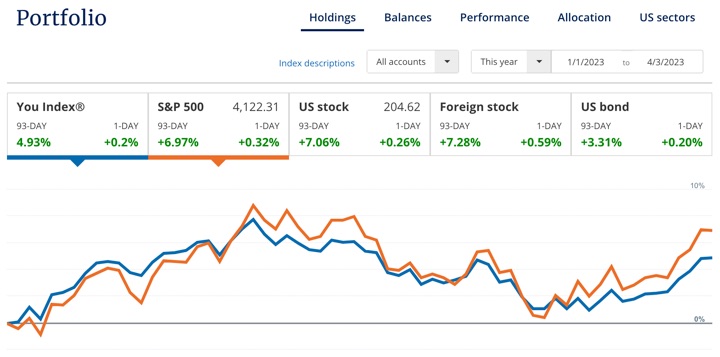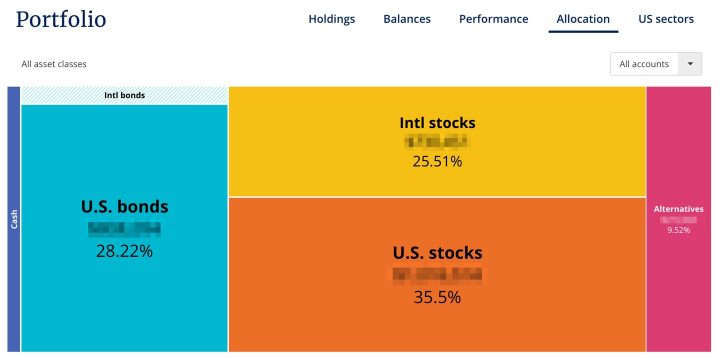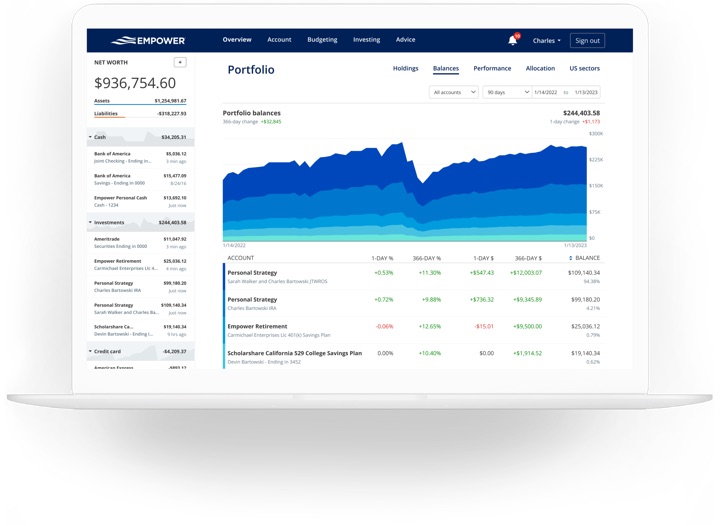Here’s my quarterly update on my current investment holdings at the end of 2023 Q1, including our 401k/403b/IRAs and taxable brokerage accounts but excluding our residence and side portfolio of self-directed investments. Following the concept of skin in the game, the following is not a recommendation, but a sharing of our real, imperfect, low-cost, diversified DIY portfolio. Wouldn’t it be nice if everyone else did the same? (Many people do track the 13F filings of well-known investors.)
“Never ask anyone for their opinion, forecast, or recommendation. Just ask them what they have in their portfolio.” – Nassim Taleb
How I Track My Portfolio
Here’s how I track my portfolio across multiple brokers and account types. There are limited free options after Morningstar discontinued free access to their portfolio tracker. I use both Empower Personal Dashboard and a custom Google Spreadsheet to track my investment holdings:
- The Empower Personal Dashboard real-time portfolio tracking tools (free) automatically logs into my different accounts, adds up my various balances, tracks my performance, and calculates my overall asset allocation daily.
- Once a quarter, I also update my manual Google Spreadsheet (free to copy, instructions) because it helps me calculate how much I need in each asset class to rebalance back towards my target asset allocation. I also create a new tab each quarter, so I have an archive of my holdings dating back many years.
2023 Q1 Asset Allocation and YTD Performance
Here are updated performance and asset allocation charts, per the “Allocation” and “Holdings” tabs of my Personal Capital account.


Humble Portfolio Background. I call this my “Humble Portfolio” because it accepts the repeated findings that individuals cannot reliably time the market, and that persistence in above-average stock-picking and/or sector-picking is exceedingly rare. Charlie Munger believes that only 5% of professional money managers have the skill required to consistently beat the index averages after costs.
Costs matter and nearly everyone who sells outperformance, for some reason keeps charging even if they provide zero outperformance! By paying minimal costs including management fees, transaction spreads, and tax drag, you can essentially guarantee yourself above-average net performance over time.
I own broad, low-cost exposure to productive assets that will provide long-term returns above inflation, distribute income via dividends and interest, and finally offer some historical tendencies to balance each other out. I have faith in the long-term benefit of owning businesses worldwide, as well as the stability of high-quality US Treasury debt. My stock holdings roughly follow the total world market cap breakdown at roughly 60% US and 40% ex-US. I add just a little “spice” to the vanilla funds with the inclusion of “small value” ETFs for US, Developed International, and Emerging Markets stocks as well as additional real estate exposure through US REITs.
I strongly believe in the importance of knowing WHY you own something. Every asset class will eventually have a low period, and you must have strong faith during these periods to truly make your money. You have to keep owning and buying more stocks through the stock market crashes. You have to maintain and even buy more rental properties during a housing crunch, etc. A good sign is that if prices drop, you’ll want to buy more of that asset instead of less. I don’t have strong faith in the long-term results of commodities, gold, or bitcoin – so I don’t own them.
I do not spend a lot of time backtesting various model portfolios, as I don’t think picking through the details of the recent past will necessarily create superior future returns. You’ll find that whatever model portfolio is popular in the moment just happens to hold the asset class that has been the hottest recently as well.
Find productive assets that you believe in and understand, and just keep buying them through the ups and downs. Mine may be different than yours.
I have settled into a long-term target ratio of roughly 70% stocks and 30% bonds (or 2:1 ratio) within our investment strategy of buy, hold, and occasionally rebalance. My goal is more “perpetual income portfolio” as opposed to the more common “build up a big stash and hope it lasts until I die” portfolio. My target withdrawal rate is 3% or less. Here is a round-number breakdown of my target asset allocation.
- 30% US Total Market
- 5% US Small-Cap Value
- 20% International Total Market
- 5% International Small-Cap Value
- 10% US Real Estate (REIT)
- 15% US Treasury Nominal Bonds or FDIC-insured deposits
- 15% US Treasury Inflation-Protected Bonds (or I Savings Bonds)
Commentary. The goal of this “Humble Portfolio” is to create sustainable income that keeps up with inflation to cover our household expenses. According to Empower, my portfolio went up about 4.9% YTD to 4/3/2023. There was only minor rebalancing with cashflows done this quarter.
Due to the rising real yield on TIPS and rising yields on nominal Treasuries and CDs, there is more incentive to micro-managed the bond side a little bit. When the real yields on individual long-term TIPS go above 1.5% and I have cash to reinvest into bonds, that is what I am buying. As usual, I am trying to maintain high yields across a 1 to 5 year ladder horizon by picking between savings accounts, no-penalty CD, longer-term 5-year CDs, and longer-term Treasuries. However, I am also balancing between the extra yield from opening a new account or just staying with an existing bank where I already have a relationship.
I’ll share about more about the income aspect in a separate post.

 The Best Credit Card Bonus Offers – 2025
The Best Credit Card Bonus Offers – 2025 Big List of Free Stocks from Brokerage Apps
Big List of Free Stocks from Brokerage Apps Best Interest Rates on Cash - 2025
Best Interest Rates on Cash - 2025 Free Credit Scores x 3 + Free Credit Monitoring
Free Credit Scores x 3 + Free Credit Monitoring Best No Fee 0% APR Balance Transfer Offers
Best No Fee 0% APR Balance Transfer Offers Little-Known Cellular Data Plans That Can Save Big Money
Little-Known Cellular Data Plans That Can Save Big Money How To Haggle Your Cable or Direct TV Bill
How To Haggle Your Cable or Direct TV Bill Big List of Free Consumer Data Reports (Credit, Rent, Work)
Big List of Free Consumer Data Reports (Credit, Rent, Work)
Jonathan,
When do you rebalance and why did you pick that time to rebalance? (Also how often)
I try my best to rebalance whenever I have new cashflows, either new work income or by reinvesting dividends and interest in the underperforming asset classes to get back to the target. If the percentages are off more than 5% (an arbitrary number, but it does take a pretty big market movement to get there), then I will manually rebalance. I don’t force myself to rebalance once a year, like some strategies.
Jonathan, does Empower/personal capital allow to combine investments for you and your spouse so you get to review the performance together or does it only pull data from only your account? Please advise.
It pulls from whatever accounts you put in it. You can choose to have two Empower accounts for you and your spouse, or one combined account (like we do) which shows the entire picture of both accounts.
I don’t think Empower has the ability to check for ownership (which is good), so you just provide the login details (which they don’t store anywhere as all of these account aggregators claim) and they pull out your numbers and then analyze them.
Thank Jonathan and David for providing insight. I am concerned with sharing login credentials despite their claim of not storing anywhere. If they did not store, how do they access the information to refresh the numbers for analysis everytime we look into their portal. How concerned should we be sharing login credentials? Do they offer any guarantee/insurance in case of any hack into their systems?